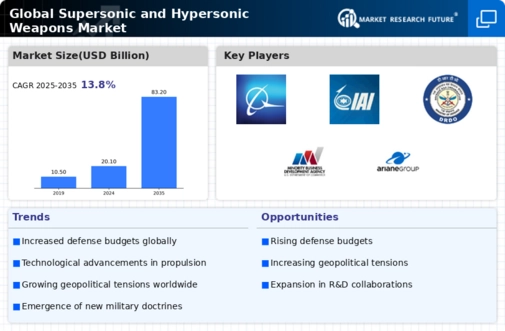Market Share
Supersonic and Hypersonic Weapons Market Share Analysis
In the ever-evolving landscape of the Supersonic and Hypersonic Weapons Market, companies employ a variety of strategies to establish and enhance their market share. These strategies are essential for navigating the competitive environment of the defense industry, where technological advancement, reliability, and strategic positioning are paramount considerations.
Product differentiation serves as a fundamental strategy in the Supersonic and Hypersonic Weapons Market. Companies endeavor to differentiate their offerings by developing innovative weapons systems with unique features and capabilities tailored to military requirements. This may entail the integration of cutting-edge propulsion systems, advanced guidance and targeting technologies, and enhanced stealth capabilities into their weapons platforms. Additionally, companies focus on designing weapons that can operate at ultra-high speeds, enabling rapid response and increased lethality against evolving threats. By providing differentiated products that address the specific needs and challenges of modern warfare, companies can gain a competitive edge and capture market share in this specialized sector.
Cost leadership is another critical strategy in the Supersonic and Hypersonic Weapons Market, particularly as defense budgets continue to face constraints in many regions. Companies strive to optimize production processes, streamline supply chains, and leverage economies of scale to offer cost-effective solutions for their weapons systems. By providing affordable yet reliable and technologically advanced weapons platforms, companies can appeal to budget-conscious defense agencies and gain market share, especially in price-sensitive segments of the market.
Segmentation plays a significant role in market share positioning in the Supersonic and Hypersonic Weapons Market. Companies identify and target specific market segments based on factors such as military branch, mission requirements, and geographical location. For instance, they may tailor their weapons systems to meet the unique needs of air, land, or sea-based platforms, or develop specialized systems for offensive or defensive operations. By understanding the diverse requirements of different segments, companies can develop targeted marketing strategies and customized solutions that resonate with their target customers, thereby maximizing their market share within each segment.
Strategic partnerships and collaborations are essential for market share positioning in the Supersonic and Hypersonic Weapons Market. Companies often form alliances with defense contractors, technology providers, and international partners to leverage complementary expertise, resources, and distribution channels. These partnerships enable companies to expand their market reach, enhance their product offerings, and address emerging market opportunities more effectively. For example, collaborations with research institutions may facilitate the development of next-generation hypersonic propulsion technologies, giving companies a competitive advantage in the market.
Brand reputation and trust are critical factors in the Supersonic and Hypersonic Weapons Market, where reliability, performance, and security are paramount considerations for defense customers. Companies invest in building strong brands that are synonymous with quality, integrity, and compliance with stringent industry standards and regulations. By consistently delivering reliable and high-performance weapons systems that meet or exceed customer expectations, companies can earn the trust of defense agencies and foster long-term relationships, thereby solidifying their market share and enhancing their competitive position.
Furthermore, companies in the Supersonic and Hypersonic Weapons Market must remain agile and adaptable to changes in technology, regulations, and geopolitical dynamics. This requires ongoing research and development to innovate new weapon technologies, improve system interoperability, and address emerging threats and challenges. By staying ahead of the curve and offering innovative solutions that meet the evolving needs of defense customers, companies can maintain their competitive position and seize new opportunities for growth in a dynamic and challenging market.









Leave a Comment